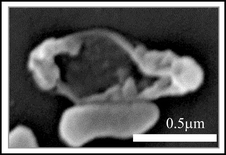Mechanistic aspects of Escherichia coli photodynamic inactivation by cationic tetra-meso(N-methylpyridyl)porphine
Abstract
The mechanistic aspects of Escherichia coli photodynamic inactivation (PDI) have been studied in bacteria expressing the reporter protein GFP, following transfection with wild type pGFP plasmid and treatment with the hydrophilic cationic sensitizer tetra-meso(N-methyl-4-pyridyl)porphine tetratosylate (TMPyP). Cell survival and morphology during PDI were correlated with plasmid-GFP degradation in comparison to DNA and RNA strand-breaks, while photobleaching of the GFP chromophore was used to monitor protein photodamage. Singlet oxygen generated upon TMPyP photoactivation interacted with target nucleic acid polymers in a drug-and light-dose dependent manner. The hierarchy and cascade of the photodamage was in the order: genomic-DNA > total RNA > plasmid-DNA, as revealed by specific extraction and agarose electrophoresis. The notable resistance of the plasmid DNA in comparison to genomic DNA has implications for PDI of antibiotic-resistant bacteria. Re-growth of the treated cells in fresh medium showed structural features of an SOS response. Under these conditions, DNA repair machinery was initiated by typical alignment of DNA–protein co-aggregates accompanied by lateral assembly of ribosomes, apart from damaged DNA-arrays, as depicted by electron microscopy. GFP–TMPyP interactions were demonstrated by double green and red fluorescence on electrophoresis plates analyzed by spectral imaging. Photobleaching measurements revealed specific GFP photodamage directly related to PDI of the E. coli. The kinetics of both the GFP photobleaching and the K+ efflux, representing photodamage to cytosolic proteins and membrane damage, respectively, were found to be similar. The survival curves were correlated to chromosomal degradation and ultrastructural damage. We conclude that TMPyP-dependent PDI of E. coli is primarily dependent on genomic DNA photodamage rather than on protein or membrane malfunctions.

- This article is part of the themed collection: Photosensitized inactivation of microorganisms

 Please wait while we load your content...
Please wait while we load your content...